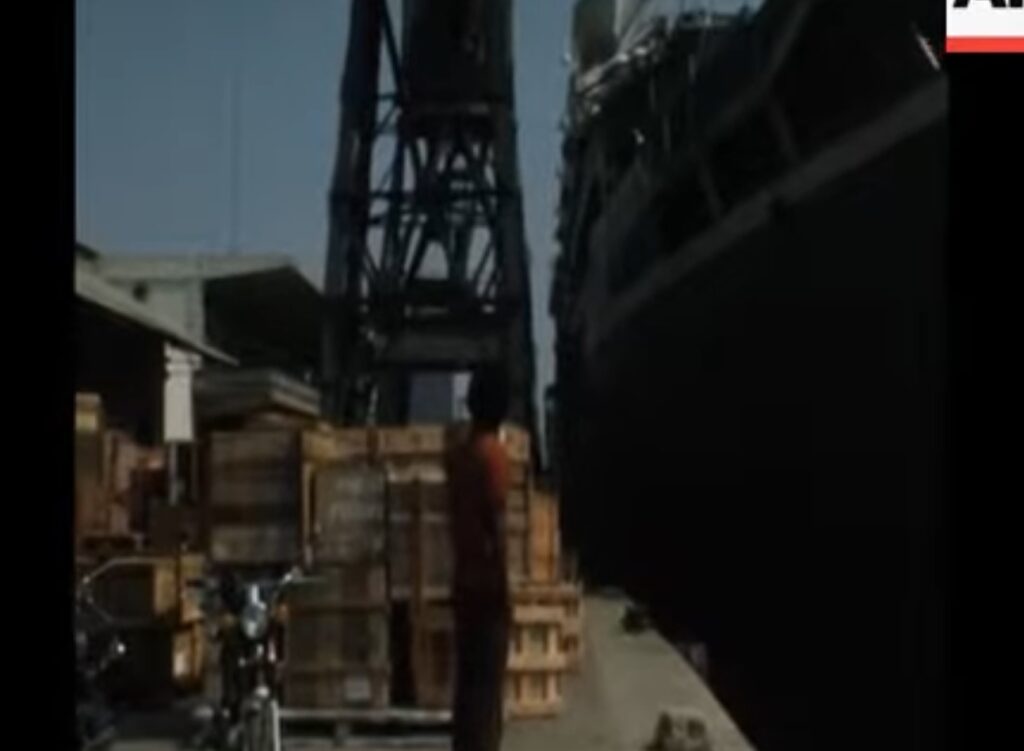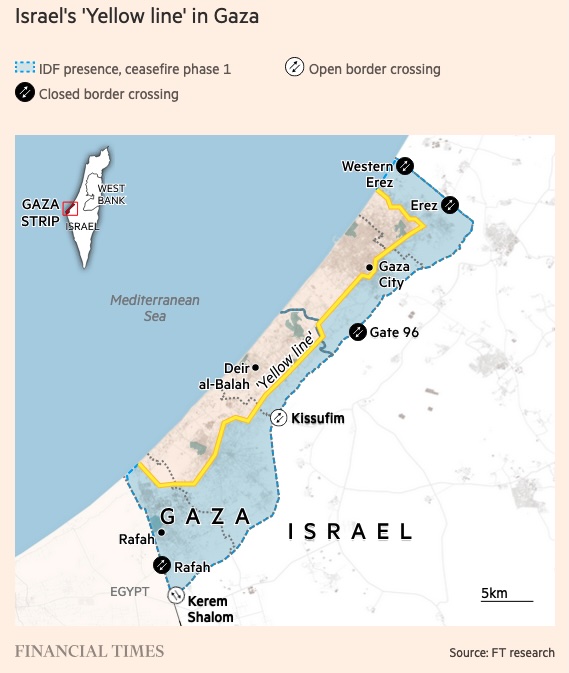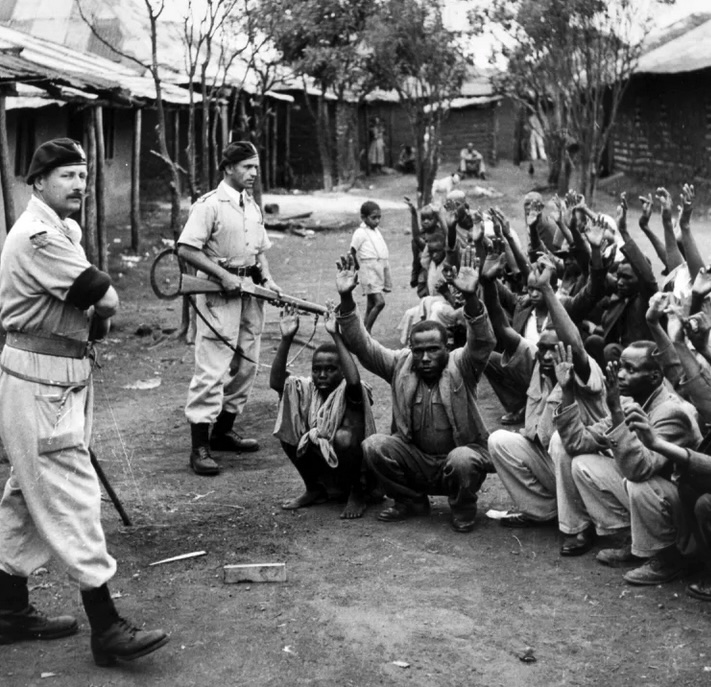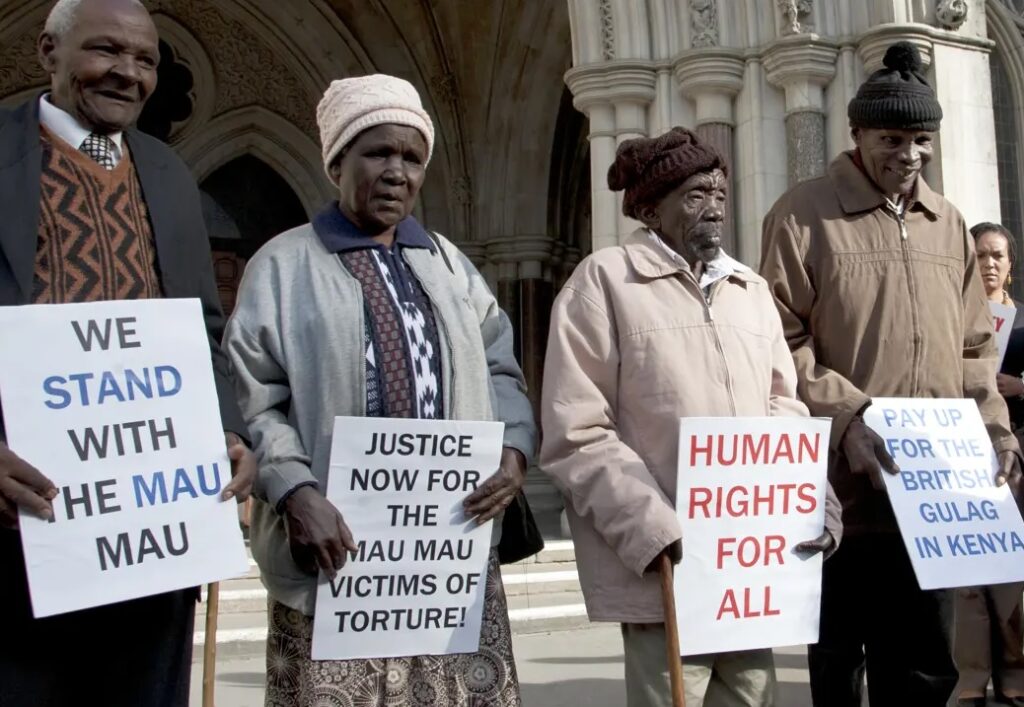Suspected Mau Mau sympathizers rounded up by British in Kenya, 1952
Imagine that, in any century from the 15th century of the Common Era through the present, you’ve made all the plans for a long-distance settler-colonial project. (Bear with me a short while here…) You’ve done a lot of prep work. You’ve pulled together the means of financing this venture and sharing the risks involved, your mode of long-distance transportation, your teams of settlers and the means of protecting their armed encroachment onto a distant land… Finally, you’re ready. You embark your well-armed teams onto your boats and go to the distant land where you want to establish your colony. Ideally you’ve landed in a place with plenty of valuable natural resources, and upon arrival you immediately set out to establish your physical control over as much of the land and resources as you can.
Then, darn it, you discover: There were people in this land before you! They’ve been here for generations. They know all the ways of this ecosystem. They know how to optimize use of its resources, its waterways, and its other means of communication. They have long-established communities with good means of communicating, traveling, and trading across far distances. They have believed for many generations that this land and its resources belong to them. And as soon as they realize that your goal is not simply to trade with them but to seize control of the land and resources, they start to resist.
Very often, their resistance is dogged, fierce, and smart. So now, like any one of the scores of European organizers of long-distance settler-colonial projects before you, you have the dilemma of “What on earth shall we do with these Natives?”
You nearly always have the option of backing down, of realizing that subduing the Native resistance is not cost-effective or is for some other reason unworkable– and of conceding that maybe you should just leave. The heads of many European trans-oceanic colonial projects throughout history, and especially in the years from the late 1940s through the mid-1970s CE, made that clear choice.

Some of those colonial projects– especially the ones the Portuguese had been running in Mozambique and Angola– had had a centuries-long history by then. But when Portugal’s settler-colonial empire proved unsustainable, some half a million people of Portuguese origin simply uprooted their lives and their belongings and left those distant African colonies. (Read more about that process here.)
And in 1962, France pulled a million settlers out of Algeria…
But if you’re determined to stay in your settler colonies, you basically have four different paths you can take for dealing with resisting Natives. These are:
- Physical Extermination. That is, killing as many of them as you can, using all the lethal practices described in the 1950 Genocide Convention.
- Chasing them completely out of the area you want to colonize. That is, large-scale ethnic cleansing.
- Trans-shipping them to some place else in your empire where, uprooted from their families and the social networks and ecosystem of their home communities, they will be almost totally vulnerable to your means of control, at which point you can start to ruthlessly exploit their labor. This practice reached its height with the sustained trans-Atlantic shipment of millions of enslaved Africans to plantations in the Caribbean and the Americas. But it was also common along West European-controlled shipping lanes that crossed other bodies of water, too. That’s how large numbers of Muslim “Malays” from today’s Indonesia ended up in Dutch-controlled South Africa.
- “Pacifying” the Natives in some place that’s closer to their original home-place, but confining them there in harsh circumstances that similarly disrupt and destroy their social networks to the extent that they are almost totally vulnerable to your means of control, at which point you can start to ruthlessly exploit their labor.
Until recently, the authors and leaders of the Zionist settler-colonial project in Palestine would rely mainly on Path 2, Chasing, though their pursuit of that would often be punctuated by periods of using Path 1, Physical Extermination, in which the terrifying nature of many of the killings was aimed at grotesquely intimidating the remaining Native Palestinians as well as at actual physical extermination. (From Deir Yassin to Gaza…)
In the present (and ongoing) U.S.-Israeli genocide in Gaza, the genocidaires’ emphasis for most of the first two years was on Path 1, physical extermination, but with occasional inquiries about the possibility of Path 2 (chasing them over the border into Egypt.) But now, here comes Pres. Trump’s son-in-law Jared Kushner (and Tony Blair) with a new plan– for “Pacification”, Path 4.

Kushner’s plan, as described here in The Atlantic (house organ of former Israeli prison-guard Jeffrey Goldberg) is that the Israeli military should stay in that 53% of Gaza’s land where they have remained since the October 13 (quasi-)ceasefire. Then, in that space east of the “Yellow Line” the U.S.-Israeli partners should build a network of what Kushner and his cronies reportedly call “Alternate Safe Communities.” (But why don’t we just call them Strategic Hamlets, instead?)
Kushner told 60 Minutes in late October that the goal would be to construct a “New Gaza” on the Israeli-held side of the line, “to give the Palestinians living in Gaza a place to go, a place to get jobs, a place to live.”
But he and everyone else in the U.S./Israeli planning team face some serious obstacles:
- Somewhere in excess of of 95% of the Gazans who have survived thus far now live in the (clearly Hamas-controlled) area West of the Yellow Line. Those are the people most desperately in need of life-saving aid. On November 5, the UN’s Shelter Cluster issued a warning that at least 259,000 families or more than 1.45 million people in Gaza face the onset of winter without adequate protection, while the Israeli military continues to block the shipment of shelter supplies. All or nearly all of those families live West of the Yellow Line.
- The Israeli military continues to undertake mass-scale demolition of homes and other civilian structures in the areas East of the Line, meaning that even there, there are vanishingly few options for providing shelter.
- The launching of any Strategic Hamlets plan needs the current quasi-ceasefire to hold and to be strengthened with the deployment of the “International Stabilization Force” that Trump described in his 20-point plan of September 29. (Note that Hamas and its Resistance allies have signed onto only six of those points. The rest, including the provisions for forming the ISF, have yet to be negotiated.) However, not a single one of the governments Trump or others have suggested might participate in the ISF has agreed to do so. All potential participants have stressed they need at the very least a UN Security Council resolution to do so. No such resolution is in sight.
The Atlantic staffer who wrote the description of Kushner’s Strategic Hamlets plan had clearly talked to some of the slightly– and rightly– wary officials who’ve been drafting it. One of the key aspects of the plan has been, according to her, that the people running the future Strategic Hamlets would encourage Gazans from West of the Line to come over and live there in the (effectively Israeli controlled) area where the Hamlets will be built– but these migrants would need to be “vetted” before they were allowed to cross the line. Now, I’m pretty certain that the U.S.-back South Vietnamese government had some similar procedure in place when they launched their Strategic Hamlets program in 1962…
(However, through a triumph of anti-colonial intel/infiltration work, the person the South Vietnamese appointed to run the program turned out to be a long-time Communist sleeper agent, who by many accounts implemented the program in such a way as to build up intense resentment of the South Vietnamese government. It is not clear whether the outcome could have been otherwise. The program itself, however it was rolled out, was anyway designed to be deeply disruptive of villagers’ long-held norms and to inflict huge suffering on them.)

The mentions in the Atlantic article of the role that anti-Resistance “vetting” would play in allowing access to any “benefits” the Kushner program might offer to Gazans also immediately reminded me of the intense and brutal “screening” the British colonial army in Kenya applied in the 1950s to suspected supporters of the Kenya Land and Freedom Party (the “Mau Mau”) there. Under the “Pipeline” program they devised against the Kikuyu, the Brits established a multi-stage network of Strategic Hamlets of varying degrees of harshness, enacting brutal “screening” of people seeking to move between them.
In 1963, London finally decided to abandon plans to maintain its long-pursued settler colonial project in Kenya and grant independence to the country. At that point, British officials deliberately destroyed or hid all the detailed records they’d kept of the Pipeline project.
The records that survived were only unearthed 45 years later– in a massive UK intel bunker in Western England– after dogged Harvard University researcher Caroline Elkins helped some of the ageing survivors of the Pipeline to sue for their release. In 2013, the British government finally accepted responsibility for the harms its military had inflicted and announced a financial settlement for 5,000 remaining survivors…
The “Pacification” (or Villageization or Strategic Hamlets) approach to dealing with the Indigenes is one with a very long role in the history of West-European settler colonialisms in the Global South. We can look back 523 years to the record of the “Reductions” that Spanish colonists deployed against the Indigenes in just about every place in the Global South where they established their colonies– from 1503 CE, on.
Those first “Reductions” were established in Spanish-conquered islands of the Caribbean/ the “West Indies”, just eleven years after Columbus had arrived there. Here is the quick Wikipedia summary of their origin:
In the words of the Spanish rulers, “It is necessary that the Indians be assigned to towns in which they will live together and that they not remain or wander separated from each other in the backcountry.” The Spanish ordered Indian villages to be destroyed and selected sites where new villages should be built. The concentration, or reducción of the Indian population, facilitated the Spaniards’ access to Indian labor, the promulgation of Christianity, and the collection of taxes and tribute.
From there, the Spanish conquistadores took their policy of “Reductions” to the North American mainland, to South America, and the “East Indies” (today’s Philippines.)
A big part of that Spanish project was the deliberate brainwashing of “Christianization”, which was often carried out by the Jesuits, who established and ran many of the Reductions. People forced into those Reductions were forced to disavow all their previous belief systems and the rituals and practices associated with them and to live according to only the tenets of Catholic Christianity. Exactly analogous, you could say, to requiring them to foreswear the worldview of the Mau Mau, or the Vietcong– or , in today’s Gaza, Hamas and its resistance allies.
We should also mention the sustained campaign of cultural genocide that the U.S. and Canadian governments undertook in the 19th and early 20th centuries against the Indigenes in these lands through the mechanism of capturing their children and forcing them into boarding schools, a high proportion of which were run by various Christian churches, including the Quakers. The parallel campaigns to corral whole swathes of Native American/ First Nation families into reservations can also be seen as a variant on the Reductions/Pacification/Strategic Hamlets theme…
In the mid-20th century, the Pacification programs that the Americans (and also, actually, the French before them) tried to apply against Indigenous resisters in Vietnam, and the one the British applied against the Kikuyu resisters in Kenya both ended up completely failing to stem the tide of national resistance and national liberation. But before they failed, those programs inflicted deep and longlasting harm on many millions of people in the targeted communities.
The Pacification/Reductions programs that the Spanish had earlier enacted on various continents did not end in such a clear way. In many of the places the Spanish had conquered, Indigenous lifeways– or the actual Indigenes themselves– were completely wiped out. Forced Christianization was “successful” throughout many or most parts of Spain’s former empire, though sizeable chunks of pre-Spanish, pre-Christianization cultural life have survived in many parts of North and South America, and the Philippines.
I could spend time speculating on what the prospects for a U.S.-Israeli Pacification program in (parts of) Gaza might be. Except that I judge it highly unlikely that any such project will get off the ground any time in the foreseeable future. Still, I think this quick survey of the long and deliberately cruel history of “Pacification” programs has been worthwhile.
Of course, you could also make the case that the whole of the Oslo process ended up being– or was designed to be– an almost classic-style Pacification program for the West Bank. But that should be another essay…



